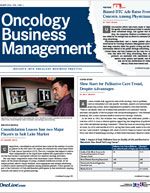Publication
Article
Oncology Business News®
ACA Deductibles and Copays Are Obstacles to Patient-Doctor Talks
Author(s):
The high cost of deductibles and copays under Affordable Care Act health exchange policies is a barrier in oncological care that renders the discussion of patient involvement in therapy choices somewhat moot.
John Fox, MD, MHA
The high cost of deductibles and copays under Affordable Care Act health exchange policies is a barrier in oncological care that renders the discussion of patient involvement in therapy choices somewhat moot, panelists said at the 4th Annual Patient-Centered Oncology Care conference in Baltimore in November.
Patients who cannot afford thousands of dollars out of pocket for a novel oncologic drug may never get as far as sitting down with their physicians to have a cost discussion, panelists said in the session titled “Reimbursement Challenges for Oncology Innovation: Who Pays?” In addition, patients may be far from having the educational background necessary to understand the treatment options available to them, and third, the choice may be only one promising drug versus others that are far inferior, panelists said.
“In many cases in oncology, there really aren’t substitutes available, so whether they can understand treatment options is not a fair question to ask. Our focus is making sure that people don’t have a barrier that’s going to prevent them from using what is the recommended treatment,” said Dan Klein, MHS, CEO of the Patient Access Network Foundation, which provides funding assistance and guidance for patients dealing with a broad spectrum of diseases.
The priority should be bringing soaring care costs under control by getting manufacturers to price according to value, panelists said. “We pay a lot of dollars in the healthcare system for drugs that don’t work as predicted in clinical trials, and in future we’re interested in long-term arrangements with manufacturers based around paying for outcomes rather than whatever price they demand,” said John Fox, MD, MHA, senior medical director for the insurer Priority Health of Michigan. Fox is responsible for cost-of-care management and health innovations, including pay-for-value contracting.
Without the wherewithal to purchase the drugs they need, patients are simply blocked out of the treatment discussion from the very start, Klein said. This is especially true with the new insurance market where “the effort to keep premiums low resulted in a lot of cost-shifting to deductibles and to co-insurance. There’s a part of the community that is going to be unable to access products even when they’re priced reasonably—many aren’t—and the question becomes what kind of a safety net do we want?”
Nevertheless, cost discussions have become part of the patient routine for Yousuf Zafar, MD, MHS, a gastrointestinal medical oncologist and a professor of medicine at Duke Cancer Institute. “I’m starting to have a conversation with patients about how much a particular treatment may cost them, and whether it’s worth a potential month’s improvement in survival for thousands more dollars,” Zafar said. He has participated in studies on access to care, cost of care, and comparative effectiveness of care delivery between health systems.
Given that a lot of drugs offer only a marginal benefit in oncology, the idea of performance-based and targeted value-based insurance pricing makes sense, Zafar said. Still, physicians do need to discuss cost and value with patients, because financial hardship represents a form of harm that a physician is duty bound to prevent, he said.
More yardage on the oncology drug field can be covered with a discussion about right-sizing the cost of therapies, said Fox. He said the Oncology Care Model (OCM) from the Centers for Medicare & Medicaid Services will reveal how physicians prescribe drugs when they are under pressure to act economically, and he added that physician behavior has far more power to influence manufacturer pricing than payer policy.
“Will physicians make decisions to use a drug that is less costly not because it’s of value to the patient but because it’s less costly to the healthcare system? As a payer, I don’t have power to influence the cost of drugs, but physicians certainly have a lot of influence over what drugs they’re going to choose based on cost and efficacy,” Fox said.
On this point, a note of caution was sounded by Peter Bach, MD, director of the Center for Health Policy and Outcomes at Memorial Sloan Kettering Cancer Center. Bach said incentive-based systems have the potential to swing the pendulum in new directions that result in fresh evil, such as has happened with the 340B drug discount program, which has caused 340B participating institutions to shift toward prescribing more expensive drugs in order to benefit from the higher rebates they can receive. The bridge to a better healthcare system is “more quality, more pathways, more guidelines, more ways of reconciling what’s happening in that box to ensure that at least it’s up to standards,” he said.
Bach said he expects to see huge changes in profile of spending on oncology with the introduction of the OCM. “How we do projections for the gainshare will be critical,” he said in reference to the incentives to be introduced to spur physicians toward value-care practices.










